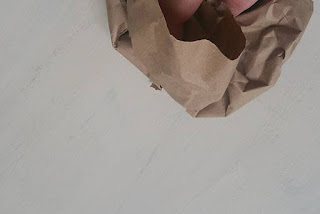I thought I grabbed a before shot, but all I could find was the picture taken prior to me picking the piece up. The top was very worn as well as parts of the legs.
For the main color I went with "Foxtrot" by Valspar as the base.
I cleaned the table with a damp rag before getting started, mixed my paint and got right to work. Overall, the piece was fairly easy to paint. It took a bit of work to get paint into all of the nooks and crannies. 2 coats of paint were used and allowed to fully dry before I started to apply the glaze.
She was looking beautiful already, but I really wanted to make the carvings stand out. To glaze the table I used a round (#10) brush and a larger standard 2" paintbrush. I also had a dry rag and a damp rag on hand to wipe off excess glaze.
Below you can see the difference between the glazed half on the right and the unglazed side on the left.
This process was completed around the entire table using both the small brush and the larger brush depending on the size of the area I was working with. On the top of the table I wiped across the remainder of stain from the brush, then gently buffed it out with a dry rag. The stain was allowed about 10 hours to set and dry before I moved on to the next step.
With this table I knew I wanted to properly seal it with something that would withstand normal coffee table wear and tear. I decided the best option was to use a polycrylic protective finish. As a rule, I try to stay away from polyurethane sealants, especially on light colored pieces because the finish tends to yellow over time. Polycrylic is a water based product and so far I have had nothing but success with it. I also knew that I wanted to keep the antique/chalky finish on this piece so I decided to use a clear matte polycrylic by Minwax. This would seal the piece but not change the overall look of it too much versus a satin which would give the table a shiny look.
The first coat was applied with another 2" paint brush in long sweeping motions on the top, sides, legs and really worked into all of the carvings. This coat was allowed to dry overnight. Before applying a second coat, I took a brown paper lunchsack and sanded the table. The paper bag has just enough texture to work out any bubbles or uneven texture that may have dried with the first coat.
A second coat of polycrylic was applied, allowed to dry and again lightly sanded. And with that, the French provincial coffee table was beautiful once more!












No comments:
Post a Comment